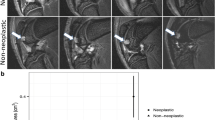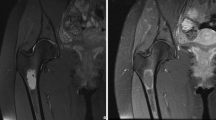Abstract
Objective. The objective of this study was to better understand the MRI appearance of massive bone allografts. Design. The MRI findings of three massive bone allografts imaged in vivo were correlated with the histologic findings following removal of the allografts. A fourth allograft, never implanted, was imaged and evaluated histologically. Patients. Allografts were placed for the treatment of primary or recurrent osteosarcoma. Results and conclusions. The in-vivo allografts have a heterogeneous appearance on MRI which we attribute to the revascularization process. Fibrovascular connective tissue grows into the graft in a patchy, focal fashion, down the medullary canal from the graft-host junction and adjacent to the periosteum. The marrow spaces are initially devoid of normal cellular elements and occupied by fat and gelatinous material. This normal postoperative appearance of massive bone allografts must not be interpreted as recurrent neoplasm or infection in the allograft. Recognition of these complications rests on features outside the marrow.
Similar content being viewed by others
Author information
Authors and Affiliations
Rights and permissions
About this article
Cite this article
Hoeffner, E., Ryan, J., Qureshi, F. et al. Magnetic resonance imaging of massive bone allografts with histologic correlation. Skeletal Radiol 25, 165–170 (1996). https://doi.org/10.1007/s002560050055
Issue Date:
DOI: https://doi.org/10.1007/s002560050055




